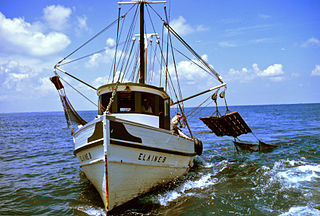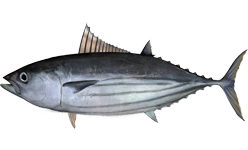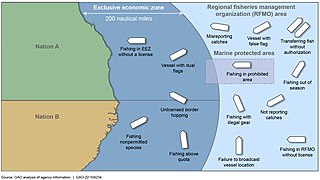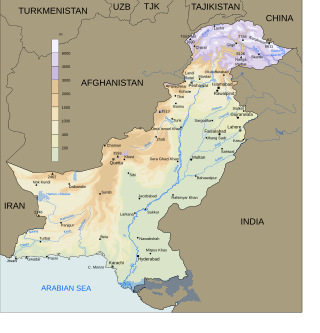
Aquaculture, also known as aquafarming, is the controlled cultivation ("farming") of aquatic organisms such as fish, crustaceans, mollusks, algae and other organisms of value such as aquatic plants. Aquaculture involves cultivating freshwater, brackish water and saltwater populations under controlled or semi-natural conditions, and can be contrasted with commercial fishing, which is the harvesting of wild fish. Aquaculture is also a practice used for restoring and rehabilitating marine and freshwater ecosystems. Mariculture, commonly known as marine farming, is aquaculture in seawater habitats and lagoons, as opposed to freshwater aquaculture. Pisciculture is a type of aquaculture that consists of fish farming to obtain fish products as food.

Seafood is any form of sea life regarded as food by humans, prominently including fish and shellfish. Shellfish include various species of molluscs (e.g., bivalve molluscs such as clams, oysters, and mussels.

Fishery can mean either the enterprise of raising or harvesting fish and other aquatic life or, more commonly, the site where such enterprise takes place. Commercial fisheries include wild fisheries and fish farms, both in freshwater waterbodies and the oceans. About 500 million people worldwide are economically dependent on fisheries. 171 million tonnes of fish were produced in 2016, but overfishing is an increasing problem, causing declines in some populations.

Overfishing is the removal of a species of fish from a body of water at a rate greater than that the species can replenish its population naturally, resulting in the species becoming increasingly underpopulated in that area. Overfishing can occur in water bodies of any sizes, such as ponds, wetlands, rivers, lakes or oceans, and can result in resource depletion, reduced biological growth rates and low biomass levels. Sustained overfishing can lead to critical depensation, where the fish population is no longer able to sustain itself. Some forms of overfishing, such as the overfishing of sharks, has led to the upset of entire marine ecosystems. Types of overfishing include growth overfishing, recruitment overfishing, and ecosystem overfishing.

A conventional idea of a sustainable fishery is that it is one that is harvested at a sustainable rate, where the fish population does not decline over time because of fishing practices. Sustainability in fisheries combines theoretical disciplines, such as the population dynamics of fisheries, with practical strategies, such as avoiding overfishing through techniques such as individual fishing quotas, curtailing destructive and illegal fishing practices by lobbying for appropriate law and policy, setting up protected areas, restoring collapsed fisheries, incorporating all externalities involved in harvesting marine ecosystems into fishery economics, educating stakeholders and the wider public, and developing independent certification programs.

The fishing industry includes any industry or activity that takes, cultures, processes, preserves, stores, transports, markets or sells fish or fish products. It is defined by the Food and Agriculture Organization as including recreational, subsistence and commercial fishing, as well as the related harvesting, processing, and marketing sectors. The commercial activity is aimed at the delivery of fish and other seafood products for human consumption or as input factors in other industrial processes. The livelihood of over 500 million people in developing countries depends directly or indirectly on fisheries and aquaculture.

The Marine Stewardship Council (MSC) is a non-profit organisation which aims to set standards for sustainable fishing. Fisheries that wish to demonstrate they are well-managed and sustainable compared to the MSC's standards are assessed by a team of Conformity Assessment Bodies (CABs).

The skipjack tuna is a perciform fish in the tuna family, Scombridae, and is the only member of the genus Katsuwonus. It is also known as katsuo, arctic bonito, mushmouth, oceanic bonito, striped tuna or victor fish. It grows up to 1 m (3 ft) in length. It is a cosmopolitan pelagic fish found in tropical and warm-temperate waters. It is a very important species for fisheries.

Illegal, unreported and unregulated fishing (IUU) is an issue around the world. Fishing industry observers believe IUU occurs in most fisheries, and accounts for up to 30% of total catches in some important fisheries.
Sustainable seafood is seafood that is caught or farmed in ways that consider the long-term vitality of harvested species and the well-being of the oceans, as well as the livelihoods of fisheries-dependent communities. It was first promoted through the sustainable seafood movement which began in the 1990s. This operation highlights overfishing and environmentally destructive fishing methods. Through a number of initiatives, the movement has increased awareness and raised concerns over the way our seafood is obtained.
Sustainable seafood advisory lists and certification are programs aimed at increasing consumer awareness of the environmental impact and sustainability of their seafood purchasing choices.
The Seafood Choices Alliance was a program of the nonprofit ocean conservation organization, SeaWeb. It was established in 2001 to bring together the disparate elements and diverse approaches in a growing "seafood choices" movement in the United States and expanded into Europe in 2005. The stated goals of Seafood Choices Alliance are to promote sustainable seafood and to make the seafood industry socially, environmentally and economically sustainable.
Seafood in Australia comes from local and international commercial fisheries, aquaculture and recreational anglers. It is an economically important sector, and along with agriculture and forestry contributed $24,744 million to Australia's GDP in year 2007–2008, out of a total GDP of $1,084,146 million. Commercial fisheries in Commonwealth waters are managed by the Australian Fisheries Management Authority, while commercial and recreational fishing in state waters is managed by various state-level agencies.
Sustainable sushi is sushi made from fished or farmed sources that can be maintained or whose future production does not significantly jeopardize the ecosystems from which it is acquired. Concerns over the sustainability of sushi ingredients arise from greater concerns over environmental, economic and social stability, and human health.
SeaChoice is an environmental advocacy group based in Canada. Launched in 2006, SeaChoice was created to increase consumer awareness around seafood sustainability in Canada. For 10 years, its primary goal was shifting seafood procurement to more sustainable options, with a focus on seafood suppliers and Canadian retailers. Having made significant progress in the retail landscape between 2006 and 2016, with many of their retail partners meeting their sustainable seafood commitments, SeaChoice set a new goal to increase sustainability throughout the entire seafood supply chain, from water to table.

The fishing industry plays a significant part in the national economy of Pakistan. With a coastline of about 1,120 km, Pakistan has enough fishery resources that remain to be developed. Most of the population of the coastal areas of Sindh and Balochistan depends on fisheries for livelihood. It is also a major source of export earning.

Living Oceans Society is a Canadian environmental organization that has been a leader in the effort to protect Canada's oceans since 1998. It is based in Sointula, British Columbia, with a satellite office in Vancouver, British Columbia. Living Oceans Society's vision states that: "Canada's oceans are sustainably managed and thriving with abundant sea life that supports vibrant and resilient communities."
The following outline is provided as an overview of and topical guide to fisheries:
Saltwater fish, also called marine fish or sea fish, are fish that live in seawater. Saltwater fish can swim and live alone or in a large group called a school.
Scott Nichols is an American inventor and marketer who is often considered to be a leader in the effort to make fish farming more sustainable. Nichols was part of the process and promotion of using a yeast rich in essential omega-3s (EPA) as an alternative food source for farmed salmon. Nichols is the recipient of the 2012 SeaWeb Innovation Award, the 2015 IntraFish Seafood International Marketer of the Year Award, a co-founder of Verlasso, and founder of Food's Future. He serves on the board of the Aquaculture Stewardship Council.














